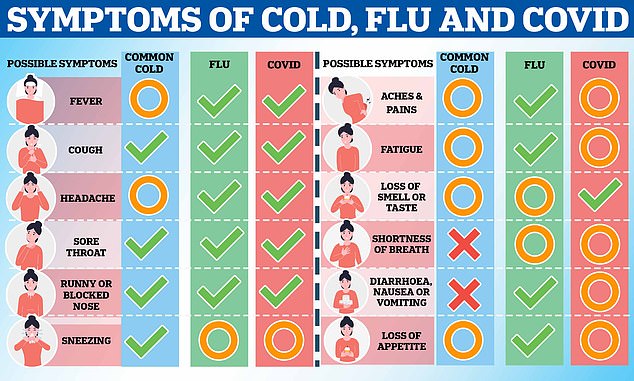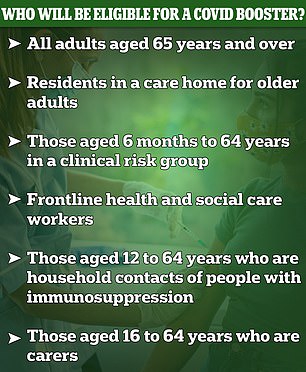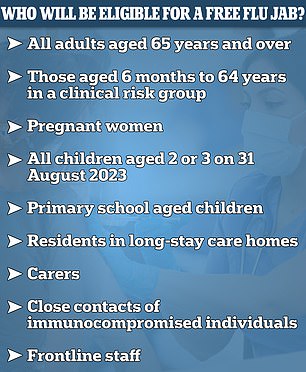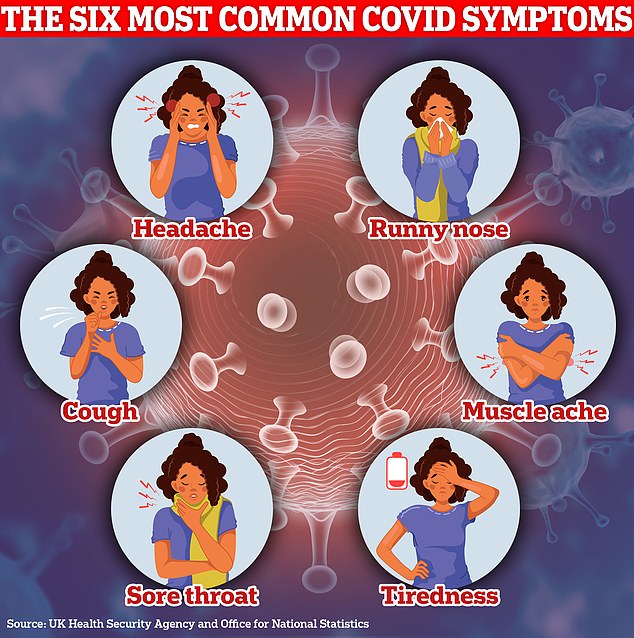Do you have Covid, flu or just a nasty cold? Ultimate guide to how to tell three diseases apart as a cocktail of seasonal insects (and a new variant!) sweeps across Britain
Britons should brace for a new resurgence of Covid, flu and other seasonal bugs, experts have warned amid a surge in cases.
Health chiefs fear outbreaks will continue to rise in coming weeks as people spend the holidays indoors with their loved ones.
January's freezing temperatures that are encouraging people to meet indoors, along with the return to offices and classrooms and a troublesome new Covid variant, are only expected to contribute to skyrocketing infection rates.
Officials urged people with coughs, sore throats or runny noses to limit contact with vulnerable groups – such as the elderly, pregnant women and those with underlying conditions – amid fears they could become seriously unwell from a virus.
So what are the telltale signs of a Covid infection? And how can you distinguish it from the flu?

Graphic shows the common symptoms (green check mark), occasional and possible symptoms (orange circle) and the symptoms that never occur (red cross) for colds, flu and Covid
Your browser does not support iframes.
Your browser does not support iframes.
Your browser does not support iframes.
Covid
At the start of the Covid pandemic, loss of taste or smell, persistent coughing and fever were the three telltale signs of the virus.
But as new variants emerged and both vaccines and repeated waves of infections blunted the virus's threat, the list of official symptoms grew.
The latest data from the Office for National Statistics (ONS) shows that headaches, runny nose and coughing are among the most common reported Covid symptoms.
Muscle pain, sore throat and fatigue were three other common symptoms, along with shortness of breath and the sudden loss of taste and smell.
Professor Philippe Wilson, an expert in biomedical engineering at Nottingham Trent University, told MailOnline: 'In addition to these primary symptoms, severe cases of Covid can lead to complications such as chest pain, confusion and bluish discolouration of the lips or face, which may appear indicates immediate medical attention.'
ONS figures from mid-December suggest one in 16 people in London had been infected with the virus, making it the worst-hit region of England in the run-up to Christmas.
Separate data released this week suggests the Juno variant, a spin-off of the Omicron strain and scientifically known as JN.1, makes up two-thirds of new cases.
The disease first began spreading in Britain in October and was spotted by the UK Health Security Agency (UKHSA) as part of routine horizon scanning – the process of monitoring emerging infections.
The variant was flagged because it contained a rogue mutation in the spike protein known to help the virus evade the body's internal defenses.
Health experts say this makes it easier for the virus to infect the nose and throat compared to other circulating variants, which the immune system can more easily fight due to vaccination and previous infections.
But there is no evidence to suggest it is more dangerous than previous species.
There are concerns this will fuel the number of people affected by the long Covid-19 epidemic – symptoms of infection lasting more than a month such as brain fog, fatigue and headaches.
However, the number of Covid-19 infections is still far from the level of earlier in the pandemic.
The number of infections rose to 4.3 million two years ago during the rollout of the original Omicron – but this was surpassed a few months later when the number reached a record 4.9 million.
The threat of Covid to many people has been drastically reduced by the wall of immunity built up by vaccines and infections.
Flu
The disease is caused by flu viruses and usually causes people to cough, the most common crossover seasonal virus symptom.
But signs of flu are usually much more intense and can even cause stomach problems. It can be fatal in some cases if complications, such as pneumonia, occur among the most vulnerable.
Your browser does not support iframes.
Your browser does not support iframes.
Professor Ron Eccles, who led the Common Cold Center at Cardiff University before retiring in 2017, told MailOnline: 'Flu symptoms usually have body symptoms such as chills, fever, headache and muscle aches.
'The flu feels worse because the symptoms affect the whole body and are not limited to the common cold.'
He added: 'Gastrointestinal symptoms such as vomiting and diarrhea are more common in flu cases.'
The latest UKHSA data shows flu admissions are increasing.
Hospital admissions in England hit 6.8 per 100,000 people in the week to December 31, up by a third in a week and ten times more than a month earlier.
But levels are lower than the same week last year (12.7), which was the worst flu season in a decade as it marked the first winter without Covid restrictions since the pandemic began – allowing the flu to spread rapidly against a background of low immunity.




Since September, health officials have urged the 30 million people in England who are eligible to come forward for their Covid and flu jabs to reduce the risk of them becoming seriously unwell and needing hospital care. Among those invited for additional doses are people aged 65 and over, care home residents, frontline health and social care workers and pregnant women


Figures released in December by the Office for National Statistics and the UK Health Security Agency showed that symptoms such as headache, runny nose and cough were among the three most common Covid symptoms reported in the week ending December 13. Other commonly recorded symptoms also include muscle pain. , sore throat and fatigue
However, experts warned that Britons who have been ill in recent weeks could have succumbed to 'two or three virus infections' at the same time, 'like a domino effect'.
Dr. Chris Smith, a virologist at the University of Cambridge, said BBC Look east: 'Many of these different diseases all occur in exactly the same way.
'They sometimes cause a runny nose, sore throat and fever – especially with flu – and sometimes you also have to cough.
'So it can be very difficult to know exactly what it is because a lot of these things all present themselves in the same way, but they are caused by many different infections.
'The other bad news is that you can catch a lot of them at once. We sometimes see people who are diagnosed with two, sometimes three, viral infections at the same time.'
He added: 'So when we say to other people, 'I had the most terrible cold at Christmas' or 'at New Year', it is entirely possible that you have succumbed to several things, all at once or one after the other. the other, like a domino effect.”
Since September, health officials have urged the 30 million people in England who are eligible to come forward for their Covid and flu jabs to reduce their risk of becoming seriously ill and needing hospital care.
They urged Britons to turn to pharmacies and local urgent treatment centers where necessary, as a spike in the number of virus patients means emergency department delays are further increasing.
Among those invited to receive additional doses are people aged 65 and over, care home residents, frontline health and social workers and pregnant women.
Cold
Rhinoviruses are the most common cause of the common cold, but a minor infection of the nose and throat can be caused by any of more than 200 different viruses.
If symptoms are mostly limited to the upper respiratory tract, you probably have a cold.
'Cold symptoms are more like colds with runny nose, sneezing, sore throat and nasal congestion,' Professor Eccles said.
Cold weather alone does not cause a cold. But the body is more susceptible to infections when the immune system is weaker.
London-based general practitioner Dr. Ann Nainan told MailOnline: 'Colds usually develop gradually and can cause coughing, congestion and tiredness. They sneak up on you with things like a runny nose or a sore throat.”
The disease is often 'nuisance', unlike the flu “can knock you over and keep you in bed,” she added.
However, this overlap in symptoms can have consequences clinical diagnoses challenging.
